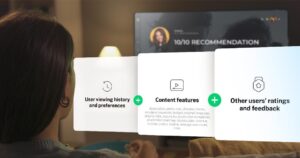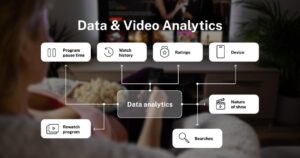
After more than 40 years of operation, DTVE is closing its doors and our website will no longer be updated daily. Thank you for all of your support.
Viewers’ feedback vs big data insights – who holds the truth?

How does a typical day in the media content world look? According to Nielsen’s latest report, the viewers are navigating the labyrinth of currently existing 2.7 million video titles over 600 streaming services and OTT providers, hoping to stumble upon that one movie or show they didn’t even know they actually wanted to watch.
Meanwhile, content creators and distributors are searching for more and more methods to truly understand their viewers, deducing if a show will make them yawn or create a raving post on social media.
And here arises a logical question: why do distributors resort to intricate spying methods to learn the desires of viewers when they can just ask them directly? Such a straightforward conversation could guarantee user satisfaction, help them build loyalty, and entice potential advertisers by demonstrating a precise grasp of their audience’s tastes and interests, right?
Unfortunately, quite the opposite. The reality is that even meticulously collected user feedback can hardly be taken as ultimate truth. Every “honest” response from a respondent is often filled with numerous traps and twists that can lead to content demand evaluations as accurate as fortunetelling.
What’s causing this and what can be leveraged to truly captivate every single user? Oxagile’s expert system analyst, with years of expertise in video solutions, sheds light on the issue, revealing insights into why viewers lie and how to extract real emotional context of every user interaction with content using big data, steering clear of misleading conclusions.
 Alexey Zaberezhniy, a video solution system analyst at Oxagile, specializes primarily in interactivity and personalization trends, aiming to enhance the value for consumers in the video streaming domain. His project expertise includes various areas such as facilitating interactive viewing experiences, implementing smart recommendations, enhancing content discoverability, etc.
Alexey Zaberezhniy, a video solution system analyst at Oxagile, specializes primarily in interactivity and personalization trends, aiming to enhance the value for consumers in the video streaming domain. His project expertise includes various areas such as facilitating interactive viewing experiences, implementing smart recommendations, enhancing content discoverability, etc.
“Everybody lies, posing a challenge when seeking meaningful
viewer feedback through surveys and diary panels.“
What does a diary panel imply in theory?

A representative group within a specific territory, diverse in terms of socioeconomic statuses, demographics, and other characteristics, keep their own diaries of what they watch during the week and what they enjoy more. These diaries are then collected and processed.
Expert perspective:
“What is a diary panel in practice? Representative groups include many individuals who choose not to acknowledge viewing specific content or simply have trouble recalling what they watched at a given time. Let’s take, for instance, an individual like Brian, who rather than admitting to not remembering something, starts imagining variants and enters the most plausible ones into the analysis. Consequently, when asked what he watched between 8 and 9 in the evening, he assumes the kind of content an average person might typically view and responds with “the news,” despite the fact that over the past year he’s actually been learning about current events only through fresh internet jokes.”
What does a survey imply in theory?
In a survey scenario, a focus group is set up to gather extensive feedback about the participants’ likes, the ways they use the service, and their overall satisfaction with the streaming platform.
Expert perspective:
“What is a survey in practice? Let’s take someone like Peter, for instance, who, when directly asked about his satisfaction with the OTT service, claimed everything was excellent and he intended to renew his subscription. However, the analytics revealed that he never actually used the service throughout the survey period. And a week after the survey he canceled his subscription, of course.
At the same time, one of the survey participants named Jack mentioned that he enjoys watching Discovery and sports, and he wishes there was more science-related content available in his TV lineup. The catch is though, the data shows he’s been watching exclusively Brazilian series, cooking shows, and The Real Housewives. However, the feeling that his TV preferences don’t quite match the statistical trends makes it awkward for him to honestly share his preferences.”
Clearly, such attempts from reviewers to guess the truth or even an unconscious desire to please the interviewers result in a higher number of misconceptions compared to simply excluding these participants from the sample. Which is also quite challenging, especially considering that sometimes, most participants fall into the category of such liars.
“The ultimate trick is deciphering the missing piece
– understanding user satisfaction.“
All of the methods mentioned above are unquestionably outdated and are rarely used in today’s context. Currently, the job is done by the automatic devices that track what’s being shown on TV, enabling getting insights into which channels people are watching and when someone from the household is tuning in. In this context, panels, referring to groups of people such as households or individuals, actively share personal information and engage in ongoing research or measurement of their media usage for a specific period. However, the trickiest aspect, often hindering sufficient data from becoming truly meaningful, is understanding whether viewers are satisfied with what they’ve just watched or not.
Expert perspective:
“Just the fact that someone tunes into a channel every day doesn’t necessarily mean they enjoy it –sometimes they might just be too lazy to switch or use it as background noise. From a viewership perspective, it’s counted in the statistics, but we need to filter out such instances to get precise insights into user preferences.”
How to detect if extended TV viewing is genuine enjoyment or simply the user leaving with the TV still running?

There are a few methods to determine how engaged a person is with the content being presented. However, each of them has its shortcomings:
- Encouraging users to like or dislike the content after they’ve finished viewing.
What’s the catch?
Typically, this method proves to be ineffective, with less than 5% of users actively engaging in this activity.
- Displaying a screen-interrupting question to check engagement, asking something like, “How do you like the show you’re watching.
What’s the catch?
If a person is truly engaged in the storyline and events on the screen, such a disruption may confirm that they are indeed watching. However, it may also prompt viewers to consider switching to another streaming service where they won’t be pulled out of the narrative by intrusive questions.
- Inquiring about viewers’ impressions of the movie or show after some time has passed.
What’s the catch?
In this scenario, the gathered feedback is delayed, which also introduces a certain margin of error.
- Conducting motivational surveys on companion devices, offering a small bonus.
What’s the catch?
The issue lies in the fact that a strong incentive may lead individuals to watch the content they dislike just to obtain the bonus. On the contrary, a small bonus might result in the survey being ignored, like the majority of the methods described above.
“Big data and AI craft tailored recommendations that hit the spot,
giving users what they want even before they realize they want it.”
In general, figuring out a specific user’s preference for a particular genre after they’ve watched a movie or two is relatively easy. However, from the perspective of a content provider, simply suggesting action movies to a user based on their prior viewing of films in that genre without any pauses, is hardly a viable approach. First of all, the supply of high-quality action films is limited on any platform. Consequently, you risk depleting the movie options to recommend over time. And secondly, as noted earlier, just because a film was watched doesn’t necessarily mean it was truly enjoyed by the viewer.
That’s why it’s crucial to safely assess the user’s reaction to other types of content to diversify their viewing preferences.
And this is where big data steps in, proving its worth in forming nuanced and precise recommendations.
1. Uncovering unobvious preferences

Expert perspective:
“In the past, when a movie was scheduled on a specific channel at a particular time, the associated metadata was quite basic, containing only core details like the title, main cast, genre, duration.
“These days, with only TV content having grown by more than 1.1 million individual programs since 2020, that basic info falls short in helping users find what they really want to watch. Plus, movies have so many aspects that sometimes viewers simply find it hard to put into words why they like a particular piece of content. So, relying on just 2 or 3 criteria for recommendations doesn’t seem to be the best idea.
“A more promising approach, on the other hand, involves gathering an extensive array of parameters, preferably exceeding 40 or so, such as award wins and filming locations, using artificial intelligence.
“By employing this strategy, well-trained machine learning models can produce impressive outcomes, often pleasantly surprising users when hitting the spot so perfectly.”
2. Making the most out of the time factor
The significance lies not only in what a person chooses to watch, but also in when they choose to do it –whether it’s a weekday or the weekend, during workdays or time off, in good or bad weather, during holidays or regular days, and considering what’s airing on nearby channels.
Expert perspective:
“As we dig deep and look at all the aspects over a longer stretch, we start to see a clear pattern, which can be considered when providing a comprehensive summary of recommendations.
“For instance, if we observe that a viewer typically tunes into the news during weekday evenings from Monday to Friday but switches to watching movies at 8:00 pm on weekends, it’s apparent that suggesting news on a Sunday evening might not be as effective as recommending a movie.
“In addition, we closely follow the viewer’s TV watching behavior. We pay attention to their pauses, observe whether they skip content, if they return to continue watching, and how many times they revisit certain segments.”
Considering TV viewing from a time-based perspective, content providers are putting together a puzzle. And the process of suggesting recommendations becomes not just about picking movies that might be interesting for a person, but about aligning them with real-life moments. This way, the recommendations match not only the content itself, but also the time when the viewer would appreciate it the most.
Expert perspective:
“If a person is an avid soccer fan who never misses a match, we can reasonably predict that if there’s a soccer game airing at the moment, they are highly likely to tune in, even if their usual preference leans towards romantic dramas at other times.”
“Big data is not a silver bullet,
even though it certainly strives to be one.“
No matter how dazzling the promises of Big Data and AI might seem in fulfilling users’ desires, especially when pitted against conventional approaches, there’s still a whole tapestry of intricacies and constraints that can’t be brushed aside.
1. Orientation towards big players
The primary goal of every content distributor is to tailor the content they distribute to perfectly fit the interests of their audience. That’s why buying data on users’ preferences from significant content discovery providers in search of something universally adored is quite ineffective. The preferences of a specific audience with some niche interests could be significantly different from the larger audience that enjoys popular platforms like Netflix.
Expert perspective:
“Naturally, one should always consider the regional, national, demographic peculiarities and cultural backgrounds of each market. If a particular operator has a user base of 40 million in Asia, while another has only 20 thousand in Sweden, shaping content strategies for the Swedish cable operator based on statistics from the Asian giant is unlikely to lead to the desired results.”
2. Accurate data processing and analysis difficulties

Having access to data about users is crucial, yet how you manage and make sense of this information holds even greater importance. And while the question of finding out what millions of viewers are watching comes down to the investment of money to acquire this data, the subsequent steps involving storing and processing this data represent a whole new level of effort.
Expert perspective:
“Unfortunately, interpreting the actions of each user is a highly meticulous task. There is no universal button that can definitively say, ‘if they clicked on this, it means they like it’, as the same actions will signify different things for different audiences.
“Therefore, processing the data correctly to understand individual preferences, viewing likes, dislikes, and behavior patterns is a unique journey for each media content operator.”
“The game is definitely worth the candle
when it comes to using Big Data for OTT.“
In Nielsen’s Streaming Content Consumer Survey, 20 percent of viewers confessed to not being able to make up their mind about the content to watch and ending up doing something else, painting a clear picture of unexplored potential for content providers to capture the attention of users with spot-on recommendations.
Expert perspective:
“Leveraging big data to tailor great viewing recommendations brings a significant benefit – cultivating a loyal user community. The higher the quality and seamlessness of the streaming service, with recommendations playing a central role, the greater the likelihood that users will remain engaged without actively exploring other options. They find the content satisfying, leading to renewed subscriptions and financial contribution.
“Additionally, possessing a wealth of data about users and their preferences enhances the platform’s appeal to advertisers. This elevates the platform’s potential to be the preferred choice for advertisers to showcase their ads – an achievement that, let’s admit, stands as the ultimate aspiration for any service provider.”
This is sponsored content.


